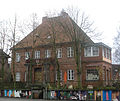Summer house (Lübeck)
With summer house or garden shed are in Lübeck architectural and social history with Hanseatic referred understated the secondary residences of Lübeck citizens before lifting Torsperre 1864 on garden plots outside of Lübeck and Lübeck city walls were created.
Emergence
The summer houses were built with the romantic turn to nature in the Enlightenment since the 18th century as secondary residences at the gates of the city and were not allowed to be used as permanent residences until the second half of the 19th century. They were mostly built in the classical style and were based on the manor houses of the Lübeck patriciate in the vicinity of the city. Even after the barrier was lifted, members of the Senate were required by the constitution to have their place of residence in one of the town houses in Lübeck's old town; in individual cases, however, a dispensation could be applied for after the barrier was lifted, which was also granted. In addition to the definition of the summer house in the narrower sense, the term summer house also continued for a while for houses built in the suburbs after the gate lock was lifted. Most of the preserved summer houses are located in the urban areas of the Lübeck-St. Gertrud , Lübeck-St. Lorenz and Lübeck-St. Jurgen . Today they are the defining and listed core buildings of the suburban areas of Lübeck, which are characterized by city villas, although in the course of industrialization at the end of the 19th century, the stocks in the St. Lorenz district largely fell victim to the massive urban development changes and are largely no longer preserved today.
Summer houses in St. Gertrud
The summer houses in St. Gertrud were built between the banks of the Trave and Wakenitz along the roads towards Travemünde and Mecklenburg, but also in Israelsdorf .
Roeckstrasse
The plots of the summer houses on the southern side of Roeckstrasse all used to extend as far as Wakenitz.
Overbeck House , Roeckstrasse No. 2
Along the Trave
The summer house plots on the Trave originally extended from today's streets Gertrudenstrasse, Am Jerusalemsberg, Eschenburgstrasse and Glashüttenweg to the Trave, but were later greatly reduced in size by the port expansion and further parcelling for residential purposes.
Villa Eschenburg, built around 1800 by the architect Christian Frederik Hansen
Israel Village
Karl von Schlözer garden house around 1857
St. Jürgen
The most representative summer house in this district is undoubtedly the Lindesche Villa in Ratzeburger Allee.
Lindesche Villa, today the registry office. Architect Joseph Christian Lillie , 1804
House wooden handle , around 1800
St. Lorenz
One of the few remaining summer houses in this district is the Bellevue palace in Rococo style from the mid-18th century. It is one of the earliest surviving summer houses in Lübeck.
The family of the consul Christian Adolf Nölting used a now no longer preserved country house next to the manor house of Gut Krempelsdorf , which belonged to the friends of the Souchay family , as a summer house . It became a place for literary and musical performances in the summer months. Emanuel Geibel's later very well-known student song A lusty musician marched on the Nile is said to have had one of his first performances here. Geibel's hen party also took place here in 1852.
literature
- Jakobine Kunhardt: Lübeck's suburbs 70 years ago. Memories of an old woman. 2., ext. Edition. Lübeck 1898.
- Bernhard Eschenburg: The development of the suburb of St. Gertrud from the sixteenth century to modern times. Lübeck 1905 (also in: Mitteilungen des Verein für Lübeckische Geschichte und Altertumskunde. Issue 12, 1905, pp. 5-60).
- Uwe Müller: St. Gertrud . Lübeck 1986, ISBN 3-7950-3300-4 . (Small booklets on city history, published by the archive of the Hanseatic City of Lübeck , booklet 2)
- Karl Heinz Augsten (Ed.): St. Jürgen. Pictures of a suburb of Lübeck . Lübeck 1988, ISBN 3-7950-1208-2 .
- Annaluise Höppner: A trip to the summer houses and gardens in the old Lübeck suburbs with a short cultural history along the way. Weiland 1993, Lübeck, ISBN 3-87890-069-5 .
- Rolf König: The suburb of St. Jürgen . Schmidt-Römhild, Lübeck 1998, ISBN 3-7950-1226-0 .
- Meike Müller: St. Jürgen. 2nd edition Lübeck 1998, 2001, ISBN 3-7950-3113-3 . (Small booklets on city history, published by the archive of the Hanseatic City of Lübeck , booklet 14)
- Elke P. Brandenburg: St. Lorenz . Lübeck 2001, ISBN 3-7950-3116-8 . (Small booklets on city history, published by the archive of the Hanseatic City of Lübeck , booklet 17)
- Michael Hundt: From the swampy meadow to the ornament of the city. The history of the development of the city park in Lübeck and its peripheral development. In: Journal of the Association for Lübeck History and Archeology. 83 (2003), pp. 169-205.
- Jan Zimmermann : St. Gertrud 1860-1945. A photographic foray. Bremen 2007, ISBN 978-3-86108-891-2 .
Individual evidence
- ↑ Lübeck's suburbs seventy years ago , in: Supplement to No. 18 of the Lübeckische Blätter from May 2, 1897.






